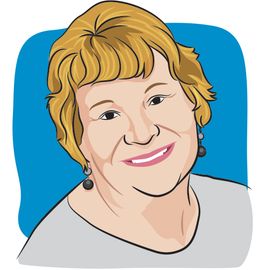- About Us
- Advertise / Support
- Editorial Board
- Contact Us
- CancerNetwork.com
- TargetedOnc.com
- OncLive.com
- OncNursingNews.com
- Terms & Conditions
- Privacy
- Do Not Sell My Information
- Washington My Health My Data
© 2025 MJH Life Sciences™ and CURE - Oncology & Cancer News for Patients & Caregivers. All rights reserved.
I’m in Awe at How My Oncology Team Works Together

Jane Biehl is a 12-year survivor of a very rare form of blood cancer, known as myelodysplastic syndrome (MDS). She has enjoyed several exciting careers including a librarian, counselor, teacher, and writer. She loves to write about surviving cancer, overcoming hearing loss and the wonderful benefits of having a hearing-ear service dog.
My oncology team works together to take great care of myself and other patients.
One of my favorite parts of reading the wonderful articles of all the bloggers on CURE is that we all feel so passionate about our oncology teams, who work so hard to keep us functioning and cure us. I personally feel that any professional who works with cancer patients has a special calling and several of these employees have told me they would not do anything else.
I have written several articles in the past about the making of an oncologist, the angels called nurses who take care of us, and the staff who risked their lives during the shutdown of COVID-19. Additionally,there are the people in reception areas, scribes, phlebotomists and many others who are all dedicated to making life easier for us and the doctors.
The oncology staff proudly tells me it is different working on a cancer inpatient or outpatient floor than anywhere else in the hospital. They get to know the patients better because they come in daily or weekly or monthly for treatments for years. Many of the staff has been there since I started my journey in 2010
I pondered this when I read Michelle Obama’s latest book “The Light We Carry.” She tells a fascinating story about living in the White House and one of the projects she did there. She and others would plant what is called a “Three Sisters” vegetable patch on the South Lawn. The patch was a mix of three common vegetables which included corn, beans and squash. They were copying a Native American tradition.
I feel that most of us do not study or know enough about the Native American culture, and they have a lot to teach us. They have grown these three vegetables for hundreds of years, and each plant has a vital part in the course of nature to help others survive. The corn grows tall and provides a pole for the bean plants to climb. Meanwhile, the bean’s purpose is to provide nitrogen, which is an important nutrient to help plants grow. The job of the squash is to stay low to the ground, which blocks weeds and keeps the soil moist. Even more fascinating to me is that these plants grow and are harvested at different times, but together they are healthy because the balance is what is important.
We often do this in our families, on our jobs, and volunteer work whether we realize it or not. Each one of us has the strength to assist the others. On an oncology wing, the oncologists need to set the protocol, the nurses carry out the orders and administer the treatments and the staff keeps the place running so all the patients receive their treatments in a timely manner.
The next time you go in for an appointment, think about the corn and beans and squash which help each other to grow and thrive so we can eat them and live. The wonderful people who help us are doing the same thing to keep us alive at the cancer centers. What an awesome thought and I am very grateful!
For more news on cancer updates, research and education, don’t forget to subscribe to CURE®’s newsletters here.
Related Content:



